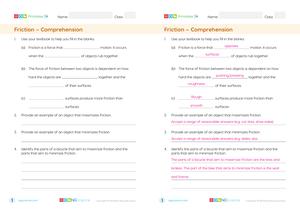Begin the lesson by discussing the everyday experience of pushing a book across a desk. This simple demonstration helps students visualize how friction acts as a force that opposes motion.
Go to the LessonLearning Objectives
- Explain the concept of friction and how it opposes motion between surfaces.
- Identify factors that affect the magnitude of friction between two surfaces, including surface roughness and the force pressing them together.
- Describe ways in which friction can be both beneficial and detrimental, and how it can be increased or decreased for specific applications.
- Discuss real-world examples of how friction is managed in various scenarios, such as in sports and transportation.
Introduction and Hook
Introduce the concept of friction and its role in everyday life. Use examples such as sliding on a playground slide or the grip of hiking boots.
Direct Instruction
Explain the factors affecting friction, such as surface roughness and the force pressing surfaces together. Use the book and desk example to illustrate these concepts.
Discuss the dual nature of friction, highlighting how it can be both beneficial and detrimental in different scenarios.
Guided Exploration
Watch the video 'Forces in Action on the Football Field – Quiz Edition' to see real-world applications of friction and other forces. This video helps students understand how forces affect motion in sports.
Engage students in a discussion about how friction is managed in sports and transportation, using examples from the video.
Hands-On Activity
Conduct an experiment where students measure the frictional force by sliding different materials across various surfaces. This activity helps them understand how surface texture and weight affect friction.
Independent Practice
Assign students to find examples of friction in their daily lives and describe how it is beneficial or detrimental. This task encourages them to apply their understanding of friction to real-world situations.
Check for Understanding
Review and Reflection
Have students reflect on what they learned about friction and how it applies to real-world scenarios. Encourage them to discuss how they might use this knowledge in everyday life.
Assessment and Extension
Administer the 'Forces and Motion' assessment to test students' understanding of the concepts covered in the lesson. This assessment includes questions that require critical thinking and application of forces and motion principles.
Try the QuizEncourage students to explore further by researching how friction is managed in different industries, such as automotive or sports equipment design.



